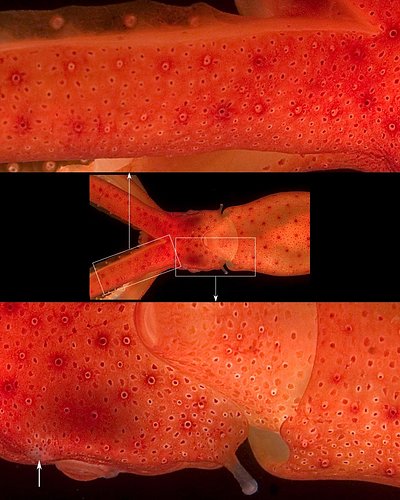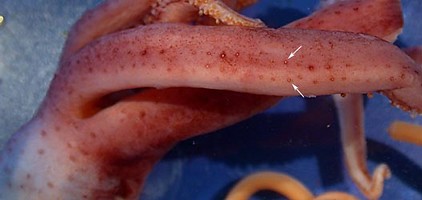The photophore pattern in members of the M. agassizii Group is almost always destroyed during capture. We show here the photophore pattern in an M. agassizii taken alive and in virtually perfect condition during a cruise run by Marsh Youngbluth, Harbor Branch Foundation. We have not yet found differences between the photophore patterns of M. agassizii and M. dentata, but the patterns are poorly known. The pattern in M. psychrophila, however, is very different (see below).
- M. agassizii, North Atlantic, 40°N, 68°W.
 Click on an image to view larger version & data in a new window
Click on an image to view larger version & data in a new window
Figure. Ventral view of the integumental photophores and chromatophores of M. agassizii. The larger photophores of arms IV are in two series. The photograph is of a living squid taken in a shipboard aquarium by David Shale and shows exceptional detail. Arrow points to the window to the eyelid photophore. The small white spheres are most easily seen in the lower image near the base of the oflactory organ. Note the difficulty is distinguishing photophores in various stages of development from ringed-chromatophores. ©
 Click on an image to view larger version & data in a new window
Click on an image to view larger version & data in a new window
Figure. Ventral view of mantle photophores of M. agassizii, same specimen as above. The rectangle indicates a region of the mantle where large photophores are absent. The intensity of the red color in these photographs of M. agassizii has been artifically reduced to aid viewing of details. ©
- M. agassizii, North Atlantic, Gulf of Mexico, tropical form
- M. psychrophila, South Atlantic, 39°19'S, 03 °15'W.
 Click on an image to view larger version & data in a new window
Click on an image to view larger version & data in a new window
Figure. Aboral view of the proximal region of arm IV, M. psychrophila, 64 mm ML, preserved. Larger photophores are arranged is 3-4, somewhat irregular, series. This small specimen, captured near the presumed northern limit for the species, apparently belongs to M. psychrophila. Note the very different arrangement of arm photophores between this arm and that in the other photographs of the M. agassizii group. Composit photograph by R. Young.
- M. dentata, eastern tropical Pacific, 7°21'N, 79°35'W.






 Go to quick links
Go to quick search
Go to navigation for this section of the ToL site
Go to detailed links for the ToL site
Go to quick links
Go to quick search
Go to navigation for this section of the ToL site
Go to detailed links for the ToL site